 |
|||||||||||||||
STORY LINK: Sending Our Curiosity on Space Daily |
||
Sending Our Curiosity to Mars Getting the Mars Science Lab to the surface is a tough proposition by Michelle Evans, July 2012
After more than eight months en route to the red planet, NASA’s nuclear-powered Mars Science Laboratory, or MSL, is nearing final approach for a touchdown on the evening of August 5. As has become tradition with the space agency, they put out a call for students to name the newest rover, with the winner this time around being Clara Ma, a twelve-year-old student from Lenexa, Kansas. She wrote: “Curiosity is an everlasting flame that burns in everyone’s mind. It makes me get out of bed in the morning and wonder what surprises life will throw at me that day… Curiosity is the passion that drives us through our everyday lives. We have become explorers and scientists with our need to ask questions and to wonder… We will never know everything there is to know, but with our burning curiosity, we have learned so much.”
With Clara’s eloquent words, the name “Curiosity” was rightly affixed to our latest emissary from Earth to Mars. If the mission lands successfully, and fulfills its promise of a minimum two-year life roving far afield on the martian landscape, we can expect a great satisfaction in our curiosity of what makes our neighboring planet tick.
After the launch aboard an Atlas V booster on November 26, 2011, from Cape Canaveral Air Force Station, Florida, MSL has had a relatively quiet cruise through deep space. What lies ahead will be anything but quiet. What has been described as “seven minutes of terror” — or to use the NASA technical term of Entry, Descent, and Landing (EDL) — will make the thundering launch seem like a cake walk. Striking the atmosphere at an oblique angle, traveling 13,200 mph, the deceleration force could climb to as much as 15 gs in just 85 seconds, raising the temperature of the heat shield to 3,800 degrees F.
To pick up the story of what happens next during this critical phase, I spoke with Steve Lee, the MSL manager for guidance and navigation at the Jet Propulsion Laboratory in Pasadena, California. Steve said, “We’re landing in a brand new way with the Mars Science Laboratory. It’s called the sky crane technique. It’s necessitated by a much larger and heavier rover, which meant that it was no longer possible to use the air bag system that’s been used on previous rovers. With this system, we will come in on a parachute, which is similar to what we’ve done before. Then, when we get about 5,000 feet above the ground, the rover, with the rocket pack descent stage attached to its back, will detach from the parachute, maneuver to avoid hitting the parachute again, set up over our landing site, descend toward the ground, and at sixty-six feet above the ground we release the rover on a series of lines we call a bridle, lower the rover down to the ground, the rover touches down on its wheels, then that descent stage rocket pack cuts loose those bridle lines and flies away to crash 300 yards [from MSL]. The rover is then ready to do its mission.”
During those minutes from entry to landing there will be six different configurations as the spacecraft sheds pieces, leaving only a rover sitting sedately on the surface to begin its mission. A total of seventy-six pyrotechnic devices must fire precisely during this sequence to land Curiosity safely on Mars. Of course this isn’t the first time something like this has been done since we’ve successfully landed on Mars six times previously. However, that doesn’t include those which didn’t phone home, such as our original Mars Polar Lander in 1999 or the European Space Agency’s Beagle 2 in 2003. Landing on Mars is hard.
Steve Lee explains that, “On this EDL we have a tremendous number of improvements. One is the sky crane technique which allows us to land a rover which is four to five times heavier. We also have a new guidance entry scheme where we actually keep track of how the atmosphere might be pushing the capsule around during the entry phase, and maneuver through the atmosphere so we can steer ourselves back on target, and can land closer to the center of our landing zone. That allows us to reduce what on the Spirit and Opportunity missions was a 120-mile long landing track down to only twelve-miles.
The great success of the previous American rovers Sojourner, Spirit, and Opportunity, was credited with an air bag system to cushion the hard knocks of landing in such a thin atmosphere. As Steve said, air bags could not be used this time around since the MSL weighs in at a hefty 2,000 pounds, and is similar in size to a small compact car. Steve is convinced the sky crane will work just fine this first time out, saying, “We spent a lot of time testing it, simulating it, and thinking it through, so we go into the landing with a lot of confidence that it’s going to work… It’s hard to say one is more difficult than the other, riskier than the other, but I think that overall sky crane is certainly more complex.”
Rob Manning, MSL’s chief engineer, agreed. “It’s one of the most complex engineering projects that we’ve ever done. In fact, it’s by far the most complex interplanetary vehicle we’ve ever engaged ourselves in.” But that doesn’t dampen Rob’s enthusiasm of what is to come, saying, “We’re really excited. After so long it’s really fun to think that all this work is going to come to fruition. The effort to get this thing to learn how to land has been unbelievable. There’s someone checking all of these pieces, then there’s someone else double-checking those pieces to make sure it all works properly.”
What does this added complexity get for us in return? Rob states emphatically, “It certainly has ten times the capability, too. Think about it, we had to go from a roving geologist, to a roving geochemist. Geochemists, when they take their samples in the field, they put them in their backpack and take them home. What we have to do is put the university laboratory and shrink it down to fit inside part of this vehicle. It’s incredibly complex. We have dozens of these miniaturized valves, we have x-ray machines, we have gas chromatographs, a mass spectrometer, we have crystallography all going on inside that vehicle.” And even more amazing, the MSL team does all this with the power equivalency of a 110-watt light bulb.
Coincidently to the fact that it takes approximately seven minutes to get on the ground, it also happens that the current light-time distance between Earth and Mars is also about seven minutes. What this means is that just as Curiosity is on the ground, here at the Jet Propulsion Lab the first signals will just be arriving from the start of atmospheric entry. The fate of MSL won’t be known until seven minutes after it actually happens.
There was a chance we might not have known this information for two or three hours, which would have really added to the tension of the evening. However, the Mars Odyssey spacecraft, in orbit about the planet since October 2001, was successfully brought out of a safe mode (which it entered on July 11), then repositioned in the past few days to a point six minutes ahead of its previous orbit, so we will now hopefully receive word in near real time of the outcome of the landing sequence. Steve said, “From my perspective, it’s more an emotional landing night thing, because it had no impact whatsoever on the success of EDL. Within about two to three hours we’ll get all the data anyway… It would have been tolerable, but it just would have been a little more nerve-wracking than we’d have liked. And it would’ve been tougher for folks to watch and say, ‘No one knows what’s going on.’ It will certainly be much more pleasant to have that real time information… Either way it’s going to be down.”
The program manager for MSL is Mike Watkins. He talked of the meaning of the Mars Science Lab, Curiosity. “For us, it’s kind of the golden age for Mars exploration. We’re learning so much about the planet and how to get to the planet. The things that we’re learning about the Martian atmosphere, how to land, how to drive, and the radiation environment on Mars, those will help us not only do better robotic missions, such as get a sample and bring it back where we can use even better laboratories here on Earth, but will eventually pave the way for humans to go there, too.” XXXX |
|||||||||||
Guidance and Navigation Manager for Curiosity is Steve Lee. Here he speaks in front of the Mars Science Lab engineering model, used to test systems here on Earth which will be used by the actual rover while traversing Mars. |
|||||||||||
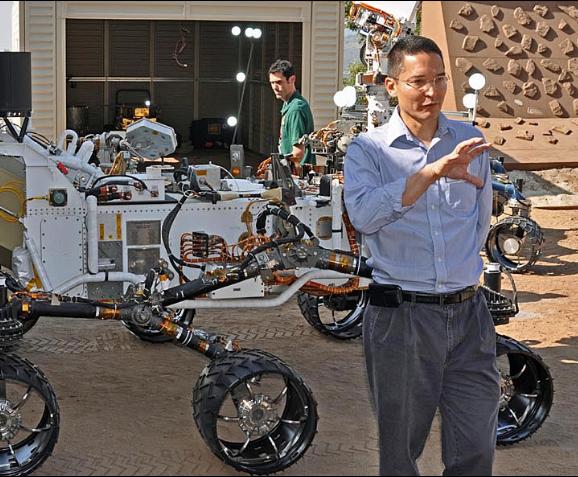 |
|||||||||||
Jordan Evans, MSL Engineering Development and Operations Manager looks like he's doing a bull fight with the rover model. |
|||||||||||
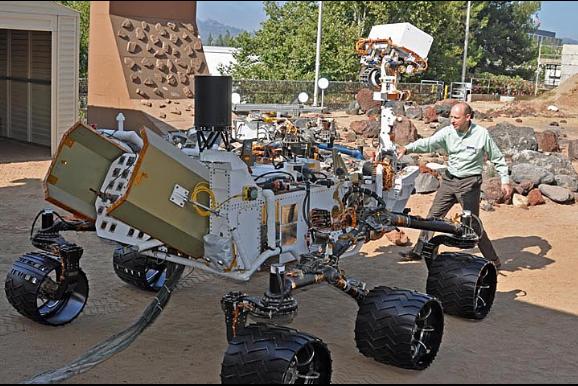 |
|||||||||||
MSL engineering model heads for a simulated martian slope. |
|||||||||||
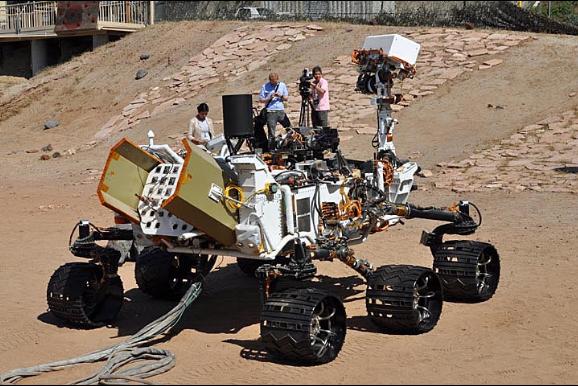 |
|||||||||||
Rob Manning, Chief Engineer for the Mars Science Laboratory. |
|||||||||||
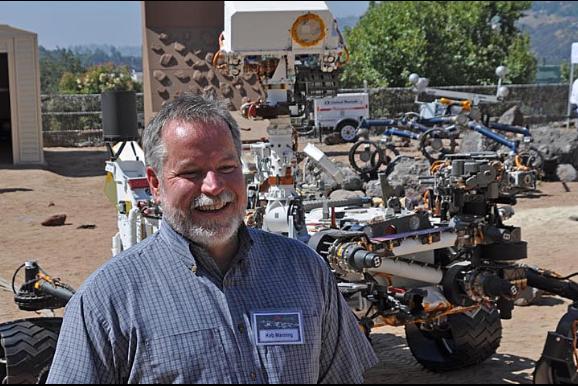 |
|||||||||||
The author with the Curiosity engineering mockup at the Mars Yard, 25 July 2012. |
|||||||||||
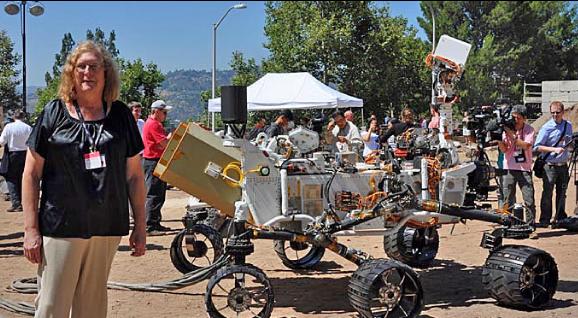 |
|||||||||||